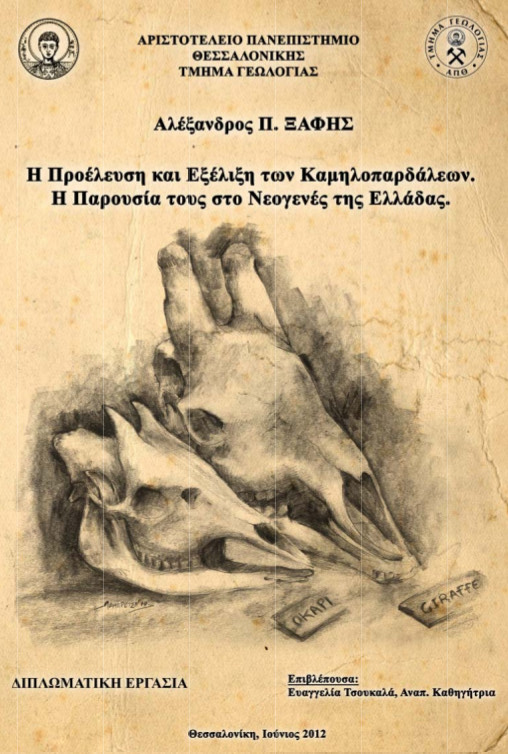
Η προέλευση και εξέλιξη των καμηλοπαρδάλεων. Η παρουσία τους στο Νεογενές της Ελλάδας
Περίληψη
The present study is an attempt to collect information from paleontological collections, museums, discussions with experts and mainly from the existing literature for understanding the origin and evolution of the representatives of the superfamily Giraffoidea. During the literature
survey, much information has been collected to describe the most representatives of the superfamily possible, as well as evolutionary, phylogenetic and paleoecological data. This work is composed into five main chapters: In the first chapter, which is the introductory chapter, general information for the families Climacoceratidae, Giraffidae and Palaeomerycidae is presented. In addition, the relations and morphological comparisons of the families and the taxonomy of the Giraffoidea are briefly described. The perspectives of evolutionary trends, like those made by major researchers such as Lamarck and Darwin, are also reported. In the second chapter, the family Palaeomerycidae is described emphasising on the subfamily Prolibytherinae, which consists of two species, which were previously included in the superfamily Giraffoidea. Thus, Palaeomerycidae can be characterized as a “sister taxon” of the Giraffoidea and the relations between the two superfamilies are recorded and analyzed. The third chapter deals with the superfamily Giraffoidea and it is divided into two sub-chapters describing Climacoceratidae and Giraffidae respectively. In turn, the subchapter of Giraffidae is divided into eight sub-chapters. Each one of these corresponds to one subfamily and includes brief descriptions of species and phylogenetic and evolutionary data, where possible. The taxonomy follows the classification by Solounias (2007). In addition, species found in Greece and other countries that enriched this systematic are described here. The taxonomy is analytically referred in the beginning of each subchapter. In general, fifty four species are described: two for the subfamily Prolibytherinae, two for the family Climacoceratidae and fifty for the family Giraffidae. The species are given with a comprehensive description and analysis emphasising on the species that have been found in the Greek area. In any case, the descriptions include general morphological characters, but especially those of the skull, ossicones, dentition and metapodials. The fourth chapter deals with the fossiliferous sites of Greece, in which giraffids have been found. The sites are listed in chronological order, ranged from Middle Miocene to Villafranchian. Information about geographical and geological location of the sites, stratigraphic structure with corresponding stratigraphic columns and palaeomagnetism data are provided, where possible. Furthermore, the fossil giraffe species are referred as well as the associate fauna of each site that are primarily related to the conformation of the Neogene of Greece. In the fifth chapter, Discussion and Conclusions are presented; a general feedback of the data that have already been reported in previous chapters, such as evolutionary biology, dietary adaptations and palaeoenvironment, while general topics on the biodiversity of the fossil species and modern giraffes are reported as well.
Η καμηλοπάρδαλη αποτελεί αναμφισβήτητα ένα από τα πιο περίεργα σύγχρονα θηλαστικά, τόσο λόγω του μεγέθους της, όσο και των ασυνήθιστων αναλογιών της. Ο ιδιαίτερα επιμήκης λαιμός δεν θα μπορούσε να αφήσει ασυγκίνητους μεγάλους επιστήμονες, αλλά και οπαδούς της
εξελικτικής θεωρίας. Παρόλα αυτά φαίνεται πως η καμηλοπάρδαλη έκλεβε τις εντυπώσεις ήδη από την αρχαιότητα, γεγονός που αντικατοπτρίζεται σε αφρικανικές βραχογραφίες, έργα τέχνης και αρχαία κείμενα. Η μυστική φύση των καμηλοπαρδάλεων απέκτησε ακόμα μεγαλύτερο ενδιαφέρον κατά τις αρχές του 19 ου αιώνα, με την ανακάλυψη του οκάπι, ενός σύγχρονου αντιπροσώπου της οικογένειας των καμηλοπαρδάλεων, από τον Sir Harry Johnston, στα τροπικά δάση του Νοτιοανατολικού Ζαΐρ. Η εύρεση απολιθωμάτων καμηλοπαρδάλεων από την Αφρική, την Ασία και ιδιαίτερα από την Ελλάδα (Πικέρμι και Σάμο), ώθησαν τους παλαιοντολόγους στην έρευνα της εξέλιξης και προέλευσης της οικογένειας Giraffidae. Η παρούσα εργασία πραγματοποιήθηκε στο πλαίσιο του μαθήματος “∆ιπλωματική Εργασία”, του Η’ εξαμήνου του προγράμματος σπουδών του Τμήματος Γεωλογίας, του Αριστοτελείου Πανεπιστημίου Θεσσαλονίκης. Αποτελεί μια προσπάθεια συγκέντρωσης πληροφοριών από παλαιοντολογικές συλλογές, μουσεία, συζητήσεις με ειδικούς επιστήμονες και κυρίως από την ήδη υπάρχουσα βιβλιογραφία, με σκοπό την κατανόηση της προέλευσης και εξέλιξης των αντιπροσώπων της υπεροικογένειας Giraffoidea. Κατά τη διάρκεια της βιβλιογραφικής έρευνας συλλέχθηκαν πληροφορίες με σκοπό την περιγραφή των περισσοτέρων αντιπροσώπων της υπεροικογένειας, καθώς και στοιχεία εξέλιξης, φυλογένεσης και παλαιοοικολογίας.
Πλήρες Κείμενο:
PDFΕισερχόμενη Αναφορά
- Δεν υπάρχουν προς το παρόν εισερχόμενες αναφορές.
